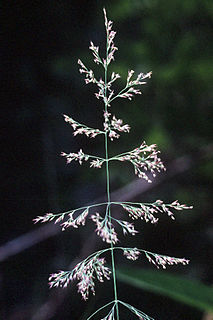
Calamagrostis is a genus of flowering plants in the grass family Poaceae, with about 260 species that occur mainly in temperate regions of the globe. Towards equatorial latitudes, species of Calamagrostis generally occur at higher elevations. These tufted perennials usually have hairless narrow leaves. The ligules are usually blunt. The inflorescence forms a panicle. Some may be reed-like.

Gaultheria is a genus of about 135 species of shrubs in the family Ericaceae. The name commemorates Jean François Gaultier of Quebec, an honour bestowed by the Scandinavian Pehr Kalm in 1748 and taken up by Carl Linnaeus in his Species Plantarum. These plants are native to Asia, Australasia and North and South America. In the past, the Southern Hemisphere species were often treated as the separate genus Pernettya, but no consistent reliable morphological or genetic differences support recognition of two genera, and they are now united in the single genus Gaultheria.
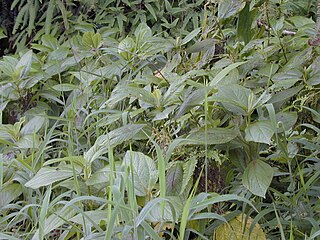
Boehmeria is a genus of 47 species of flowering plants in the nettle family Urticaceae. Of the species, 33 are indigenous to the Old World and 14 to the New World; no species is indigenous to both the Old and New Worlds. The species include herbaceous perennials, shrubs and small trees. Although related to the similar-looking species of the stinging nettles of genus Urtica, species of Boehmeria do not have stinging hairs. Because of the similarity in appearance, some species are commonly called "false nettles".

Baccharis is a genus of perennials and shrubs in the aster family (Asteraceae). They are commonly known as baccharises but sometimes referred to as "brooms", because many members have small thin leaves resembling the true brooms. They are not at all related to these however, but belong to an entirely different lineage of eudicots. B. halimifolia is commonly known as "groundsel bush", however true groundsels are found in the genus Senecio.

Arenaria is a genus of flowering plants, within the family Caryophyllaceae.

Wolffia is a genus of nine to 11 species which include the smallest flowering plants on Earth. Commonly called watermeal or duckweed, these aquatic plants resemble specks of cornmeal floating on the water. Wolffia species are free-floating thalli, green or yellow-green, and without roots. The flower is produced in a depression on the top surface of the plant body. It has one stamen and one pistil. Individuals often float together in pairs or form floating mats with related plants, such as Lemna and Spirodela species. Most species have a very wide distribution across several continents. Wolffia species are composed of about 40% protein on a dry-matter basis, about the same as the soybean, making them a potential high-protein human food source. They have historically been collected from the water and eaten as a vegetable in much of Asia.

Bulbinella is a genus of plants in the family Asphodelaceae, subfamily Asphodeloideae, first described as a genus in 1843. Many species are endemic to Cape Province in western South Africa, confined to the winter rainfall area. Other species are endemic to New Zealand, where they are most common in the central Otago region which enjoys a similar climate to the Cape Region of South Africa.
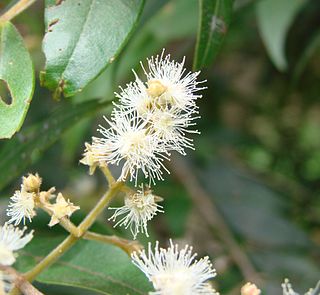
Myrcia is a genus of the flowering plant family Myrtaceae described as a genus with this name in 1827. As of 2015 it contains about 770 species. They are distributed in Central and South America, Mexico, and the West Indies.

Weinmannia is a genus of trees and shrubs in the family Cunoniaceae. It is the largest genus of the family with about 150 species. It is also the most widespread genus, occurring in Central and South America including the Caribbean, Madagascar and surrounding islands, Malesia and the islands of the South Pacific. It is absent from mainland Africa and Australia, but some fossils have been attributed to Weinmannia in Australia. Leaves are simple or pinnate, with a margin usually toothed, and interpetiolar stipules. Flowers are bisexual, white, arranged in racemes. The fruit is a capsule opening vertically from the top to the base. Seeds hairy without wings.
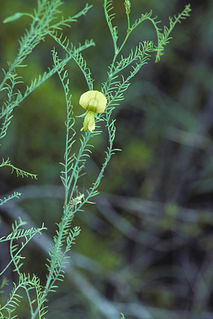
Brongniartia is a genus of leguminous plants, first named by Kunth after the French botanist Adolphe Brongniart.
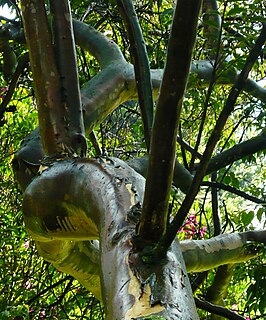
Calycolpus is a genus of the botanical family Myrtaceae, first described as a genus in 1856. It is native to the South America, Central America, and the West Indies.

Bartsia is a genus of flowering plants in the family Orobanchaceae.

Blepharocalyx is a genus of plant in family Myrtaceae first described as a genus in 1854. It is native to South America and the West Indies.
- Blepharocalyx cruckshanksii(Hook. & Arn.) Nied. - Chile
- Blepharocalyx eggersii(Kiaerskou) L.R.Landrum - Lesser Antilles, Venezuela, Guyana, Peru, Brazil
- Blepharocalyx myriophyllus Mattos - Minas Gerais
- Blepharocalyx salicifolius(Kunth.) O.Berg - Brazil, Bolivia, Peru, Ecuador, Paraguay, Uruguay, N Argentina

Siphocampylus is a genus of flowering plants in the family Campanulaceae. There are approximately 221 species native to the Neotropical realm. Most grow in mountain habitat.
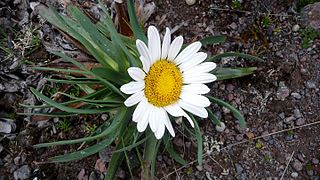
Werneria is a genus of South American plants in the groundsel tribe within the sunflower family.

Nemacladus is a genus of flowering plants in the bellflower family known generally as threadplants. Species are native to the southwestern United States and northern Mexico. These are annual herbs with very slender, sometimes threadlike, branching stems bearing small five-lobed flowers.
Diastatea is a genus of plants native to Latin America, mostly in Mexico and Central America but with one species extending southward along the Andes to Argentina.
- Diastatea costaricensisMcVaugh - Guatemala, Honduras, Nicaragua, Costa Rica
- Diastatea expansaMcVaugh - central Mexico
- Diastatea ghiesbreghtii(Kuntze) E.Wimm - southwestern Mexico
- Diastatea micrantha(Kunth) McVaugh - widespread from central Mexico to the Jujuy region of northern Argentina
- Diastatea tenera(A.Gray) McVaugh - southern Mexico and Guatemala
- Diastatea virgataScheidw. - southern Mexico
















